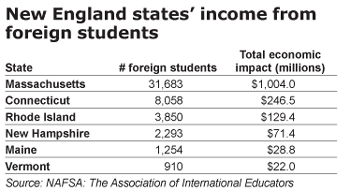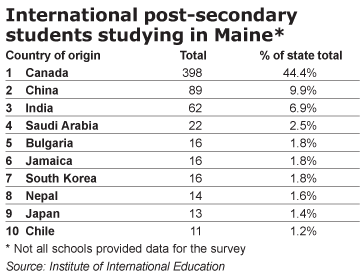Foreign affairs | Maine's colleges and universities might be missing a chance to recruit affluent international students close to home
In June, the Penobscot County town of Lee hosted some heavy-hitting foreign businessmen, including the owner of the largest manufacturer of pharmaceuticals in China.
It wasn’t a business trip or a trade mission that attracted them. It was a graduation.
Every year, Maine private schools like Lee Academy attract hundreds of students from across the globe. Lee Academy has roughly 70 international students, most of whom come from wealthy families with business clout. The president of the Korean Small Business Association has a son there. At the same June graduation, the heir apparent of a large Korean automobile factory received a diploma from Lee Academy, as did the child of the largest glass manufacturer in China.
Bruce Lindberg, Lee’s headmaster, sees no end to the opportunities that Maine and its university system could garner from the foreign ties made at Maine’s private secondary schools. “Obviously, if we can keep these students in Maine, whether it be a UMaine school or Bowdoin, Bates, Colby, the state of Maine can only profit from this fact,” Lindberg writes in an email from Shenzhen, China, where Lee Academy is opening its first satellite campus in September.
International students also have a direct economic impact on the communities where they attend school. In the 2007-2008 school year, Maine’s high schools and post-secondary institutions attracted 1,200 international students who contributed $28.8 million to the Maine economy, according to a report released in January by the Maine International Trade Center. The largest contingent of foreign students studying at Maine post-secondary schools are from Canada (44.4%), followed by China (9.9%) and India (6.9%). The latest research shows that 60% of the foreign students pay their own way without the help of grants or loans, which means they provide real income to the schools they attend.
But, is Maine squandering this opportunity?
Lindberg believes it is. Only one international student from Lee Academy will attend a Maine post-secondary school this year. “The Maine colleges and universities are missing a tremendous opportunity,” Lindberg writes. “For little financial investment, they could actively get bright, financially sound students right in their backyards.”
Karen Boudias, director of UMaine’s office of international programs, acknowledges there isn’t much money to recruit foreign students. Her office, which has seven employees, is tasked with everything from managing study abroad programs to lining up visas for foreign students. When there’s extra money, she’ll run some ads with companies that recruit international students, but ultimately, the school’s recruitment mainstay is word of mouth. “We don’t really have [a budget]. That’s sort of the problem,” she says. “That’s why we like word of mouth. … [The students] are wonderful ambassadors for us.”
The passive approach is not aggressive enough, according to Lindberg. “Rather than waiting for the students to select them, the schools need to be aggressive and go to each of the town academy campuses and personally recruit the students,” he writes. “International students desire first-person attention.”
He also touts Lee Academy’s new satellite school in Shenzhen, China, as an opportunity for the state. “The Chinese government has a very significant presence at this school already and if the reps of Maine came, it would certainly bode well for economic development for the state,” he writes.
Foreign students, local revenues
With local student populations diminishing over the last several decades, many Maine schools have found that recruiting college-bound international students has stabilized revenues and allowed the schools to improve programs for all students. In addition, international students have a decided economic impact on local communities.
Jay Brennan, associate head for admissions and residential life at Foxcroft Academy in Dover-Foxcroft, estimates the school’s nearly 80 international students each spend between $1,500 and $2,500 annually in the local community. “That’s huge,” he says. “That’s good for the community.”
Foxcroft Academy is also working with the Piscataquis County Economic Development Council to help boost economic development efforts in the region. Last month, the school began to share some of its contacts in Asia and South America with the council that could lead to business opportunities, Brennan says.
As for recruitment, Foxcroft Academy sends representatives overseas a couple times a year to attend trade shows. The school also works with a number of consultants in various countries that place international students in U.S. secondary schools. The school hosts a website in China. It hosts a blog in South Korea. It hosts gatherings in various countries, so parents of Foxcroft Academy alums can introduce other parents to the school. “We’re all attracting these students and we’re doing a very good job of it,” Brennan says of Maine’s private high schools. “We’re more than willing to help post-secondary schools learn the craft, if you will. There is an investment. We do a bit of traveling. But the benefit to the community and the benefit to the school have been certainly worth the investment, and not just monetarily.”
Most of the international students who attend Maine’s private secondary schools use them as a stepping stone to American universities. Many of them want to attend highly regarded universities like Harvard and Stanford, but others opt for state-run land grant colleges in states like Indiana, Michigan and Illinois. Brennan says Maine’s land-grant universities would need to invest in promoting themselves overseas to gain name recognition and become better known to parents who are paying the tuition. “The people who are paying the bills are the parents,” Brennan says. “Especially in Asian cultures, they are the ones making the decisions where students are going to college.”
The question, Brennan says, is not how much recruiting of foreign students UMaine does on Foxcroft’s campus, but how much recruiting UMaine, which currently has more than 400 international students, does in China, Buenos Aires, Ho Chi Minh City, etc. “Michigan State has close to 1,000 Korean students. Why does Michigan State have between 800 and 1,000 Korean students and UMaine doesn’t?” Brennan asks. “I’ll tell you why. Michigan State is in Seoul every summer.”
Boudias doesn’t hold out hope that the resources will suddenly be provided to send representatives from UMaine on recruiting trips to China or India or South Korea. For now, she’s focused on activities within her budget. She’s in the process of planning an event this fall where international students attending Maine’s private secondary schools will be invited to hear a panel of international UMaine students talk about what it’s like being an international student in Orono.
The reality is, she says, there is not enough money for a more aggressive recruiting effort. “I wish it were possible [to do more],” she says. “I think it would be great. I think it would be fun to really see what we could do if we had the opportunity.”
Whit Richardson, Mainebiz new media editor, can be reached at wrichardson@mainebiz.biz.












Comments